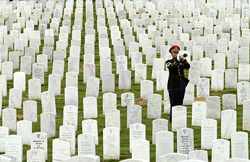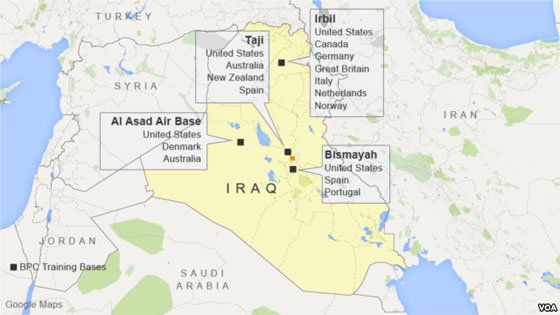Well Intended but Largely Mistaken Attacks on NCTC and DHS "War of Words" Advisories (Part 1)
In recent days, many "war of words" op-ed essays and newspaper editorials have been linked to by Small Wars Journal -- and appropriately so, for the issues they raise must surely be resolved in a far more adequate way than is now the case.
Most of these postings have been written by well-intentioned but, I think, mistaken authors who are angrily objecting to recent advisories -- not mandates but preliminary advisories -- by the National Counter Terrorism Center (NCTC) and the Department of Homeland Security (DHS) that we begin avoiding the very familiar "Jihad" (Holy War) and "mujahideen" (holy warriors) labels in the ongoing War on al Qaeda-style Terrorism.
For my own part, when I first saw these two documents long before they became public, I gave one of them a C- and the other a C+ at best -- but for reasons entirely different from those of the critics who are now attacking them in their entirety. At this point, I agree with only about half of their dozen or more specific recommendations of words to use and not to use.
Unfortunately, both of these advisories are insufficient to the situation and are, therefore, vulnerable to charges that they let both the terrorists and the despotic perversions of Islam which sponsor them "off the hook" -- and leave us with an unclear idea of exactly who and how very dangerous the "Jihadi" (but no longer to be called that) enemy really is.
This essay will attempt to describe the truth-in-language path which the NCTC, DHS, Department of State, Department of Defense and National Security Council experts should now follow in correctly and adequately defining what I have long called "The al Qaeda Apostasy" -- and doing so in several of the Islamic religious words they say should be avoided. In other words, I am a critic, too -- but in a largely constructive and supportive way rather than an angry and confrontational one.
Rather than trying to deal with each of these commentaries individually, I have selected a representative one -- a May 1, 2008 New York Post editorial, entitled "Jihad Newspeak" -- and will attempt to respond not only to its rationale and particulars but also to many of the individual columnists' worries, objections and understandable confusion.
Part # 1: Who Is at War With Whom?
As the acting NCTC Director Michael Leiter said recently to a distinguished audience at the DC-based Washington Institute on Near East Policy, we must somehow "show that it is al Qaeda, not the West, that is at war with Islam."
This strategy and practice of attacking terrorism but not Islam itself has been US doctrine from the beginning, but it is good to see this clearly and publicly reaffirmed by a senior anti-terrorism official at a time when others seem to consider Islam of the Qur'an to be the real enemy -- and view the AQ-style Terrorists as an accurate and faithful reflection of that religion, rather than a radical deviancy from it.
To make a medical analogy, we seek to kill the AQ and similar cancers without attacking the host per se -- so as not to unite the two and so as to inspire so-called "moderate" and civilized Muslims to become our allies in killing the cancer. But others are angrily blaming the host (Islam, in context of their insistence that there is only "One Islam") as being a —and inherently complicit and guilty sponsor of the terrorists rather than as a besieged and conflicted victim itself.
For his part, Osama bin Laden tries daily to paint the same "war of religions" picture as some of the hard-line critics do, albeit for very different reasons. He pontificates that this is "America's War Against Islam" and that it is, therefore, the "holy-war" and the "Will-of-Allah" obligation of every Muslim to fight back in every way imaginable.
In this vein, bin Laden's and his deputy Ayman al-Zawahiri's every appeal to their new recruits and their existing followers alike stresses the urgent need for a most holy and Godly "Jihad by faithful mujahideen and self-sacrificing young shahideen destined for Paradise -- as a proper reward for killing us infidels and destroying The Great Satan."
That's their story and they're sticking with it. The question now is whether we should accept and continue to parrot that self-serving Salafi-Wahhabi-Muslim Brotherhood-AQ mantra or "narrative" -- or should we challenge and defeat it
(1) by the sufficient condemnatory words which make it eternally evil and bound for Hellfire, rather than a matter of "holy war martyrs " bound for Paradise,
(2) by the proper religious, as opposed to politico-Islamist, frames of reference (see Part 4 below) which paint the same satanic picture of these suicide mass murderers, and
(3) by the tough counterinsurgency (COIN) strategies, operations and tactics which are founded (more on this in Part 4) upon an optimum counter-narrative?
Author's Note: For a more detailed (10,000 words) discussion of what follows -- and more --- please check my August 2007 entry in the USMA/CTC Essay Contest on National Security Strategy.
American Doctrine versus the Osaman Doctrine
One of the ways to differentiate the American doctrine from the Osaman doctrine is by carefully changing some of the incorrect words and labels we have been using in defining and discussing who is who and what is going on in in this most "irregular" of wars.
This is a language by which we have been classifying our deadly enemies as "holy warriors" and "martyrs" (because that is who they SAY they are, n'est-ce pas?) -- and which also seems to concede the Terrorists' patently false charges that we are all "infidels" and that America is "the Great Satan."
In the so-called War of Ideas, such branding of the genocidal and hyena-like terrorists by exactly the glorifying names they want to be called does not seem like a very bright idea. Truth be known, as long as two years ago but to deaf ears at the time, a distinguished former NCTC Director, John Brennan, appealed for much-needed change in an excellent Washington Post essay as follows:
"Bin Laden has also insidiously convinced us to use terminology that lends legitimacy to his activities. He has hijacked the term "jihad" to such an extent that US and other Western officials regularly use the terms "jihadist" and "terrorist" interchangeably. In doing so, they unwittingly transfer the religious legitimacy inherent in the concept of jihad to murderous acts that are anything but holy."
Despite this concern, there have been no significant changes in the last two years. And even the current recommendations which are so hotly disputed barely scratch the surface -- by recommending three or four words not be used but failing to recommend in adequate detail what other more appropriate terms (including several listed and defined below) should be used in their place. Conclusion: This is advice well intended but still quite insufficient.
An indication that it might be further refined and strengthened can be found in the fact that National Security Advisor Juan Zarate has recently observed that the AQ leadership is quite "sensitive to the perceived legitimacy of both their actions and their ideology. They care about their image because it has real-world effects on recruitment, donations, and support in Muslim and religious communities."
In addition, a well-regarded analysis of these several USG advisories by scholars Matthew Levitt and Michael Jacobson at the Counterterrorism Blog concludes that:
"Although the 'struggle of ideas in the Islamic world' section of the State Department report still focuses on the US Government's attempts to explain its policies and values, its message has undergone a serious overhaul. The initial U.S. approach in the wake of the September 11 attacks was to try and sell the United States to overseas audiences, an approach widely regarded as ineffective in stemming the tide of radicalization. Efforts will now concentrate on discrediting the terrorists."
HOORAY for that!! Better six years late than never! Such assertive discrediting -- and even such demonization -- of the AQ Terrorists and their like-minded radicals is an urgently needed tactic which is fully explained in two late-2006 TrueSpeak.org essays of mine - Urgent Need For Truth-In-Language In US Public Diplomacy and Is it Holy "Jihad" or Unholy "Irhabi Murderdom"???


